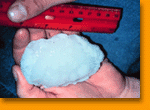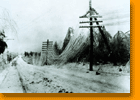P R E C I P I T A T
I O N
Precipitation:
What makes clouds, rain, snow, hail and sleet
When warm, wet air rises, it cools, and water vapor condenses out to form
clouds. A cloud is made up of small drops of water or ice crystals, depending
on its height and how cold is the surrounding air. Height and temperature
also determine whether any "precipitation" which results (from the Latin for
"to fall from") will be rain or the hail associated with thunderstorms, or
the snow, sleet and freezing rain we associate with winter weather.
 To
form rain, water vapor needs what's called a "condensation nucleus", which
can be tiny particles of dust, or pollen, swept up high into the atmosphere.
When the condensing droplets that form the cloud get large and heavy enough
to overcome the upward pressure of convection, they begin to fall. If the
temperature all the way to the ground is above freezing, then--it's raining!
When ice crystals form high up in the cloud, and it's below the freezing point
of water all the way down, then you get snow. But when there are alternating
layers of air above and below freezing, you get other types of precipitation.
To
form rain, water vapor needs what's called a "condensation nucleus", which
can be tiny particles of dust, or pollen, swept up high into the atmosphere.
When the condensing droplets that form the cloud get large and heavy enough
to overcome the upward pressure of convection, they begin to fall. If the
temperature all the way to the ground is above freezing, then--it's raining!
When ice crystals form high up in the cloud, and it's below the freezing point
of water all the way down, then you get snow. But when there are alternating
layers of air above and below freezing, you get other types of precipitation.
 If
a snowflake falls through a region of the cloud where there's liquid water
which coats the flake with more and more layers of new ice, you begin to get
hail. When the thunderstorm's updrafts are strong enough, some of the young
hailstones are swept back up and repeat their journey, getting coated with
more and more layers of ice. Eventually they grow so big that not even the
strongest updraft can keep them aloft, and so they fall to Earth, in sizes
from that of a pea to a golf-ball, and up to the record holder--6 inches long
and 17 inches in circumference! (Kansas, 1970.)
If
a snowflake falls through a region of the cloud where there's liquid water
which coats the flake with more and more layers of new ice, you begin to get
hail. When the thunderstorm's updrafts are strong enough, some of the young
hailstones are swept back up and repeat their journey, getting coated with
more and more layers of ice. Eventually they grow so big that not even the
strongest updraft can keep them aloft, and so they fall to Earth, in sizes
from that of a pea to a golf-ball, and up to the record holder--6 inches long
and 17 inches in circumference! (Kansas, 1970.)
As damaging as hail can be to houses and especially to agriculture, freezing rain can be even more lethal, especially to travelers, as they bring "ice storms" like those of 1998. Freezing rain occurs when earth and objects on the surface, such as roads, tree limbs and power cables, are at temperatures below 0° Celsius, 32° F. Above the ground, however, falling snow first encounters a layer of somewhat warmer air, which melts the flakes, and then, right above the surface, a very cold layer, which makes the liquid water "super-cooled", ready to freeze up at the slightest provocation. The trigger is encountering the freezing surfaces: what results is a thin, sometimes transparent film of ice.
 The
weight of the ice can cause tree limbs to fall across power lines, or sometimes
just drag down the lines themselves. Driving conditions are, of course, very
dangerous. This is one of the factors that make extreme heat and extreme cold
the #1 weather killers in the United States--even more lethal than lightning,
floods, tornadoes and hurricanes.
The
weight of the ice can cause tree limbs to fall across power lines, or sometimes
just drag down the lines themselves. Driving conditions are, of course, very
dangerous. This is one of the factors that make extreme heat and extreme cold
the #1 weather killers in the United States--even more lethal than lightning,
floods, tornadoes and hurricanes.